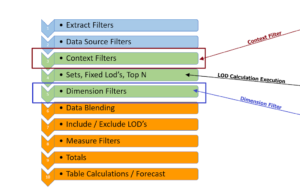We saw that Excel calculations are cell-based. Each cell contains a copy of a formula:

But with Tableau we created a new measure using custom calculations based on Dimensions and Measures

Dimensions create categories in the data (in IT speak Partitions) and Measures are the values that are related to the dimension(s)-
In the Data Frame Dimensions are above a horizontal line – in our case, there is only one Product and Measures are below the line. There are 3 – the 2 that were loaded with the data Sales $ and Quantity and the one we created with the calculation ASP (note the = to the left of the Icon #)
The simple formula SUM([Sales $])/Sum([Quantity]) creates the new measure value – and by placing Product on the Rows shelf – tableau “knows” to calculate the values at the Product level. If we had another dimension like Customer in the dataset

The same formula will produce values, subtotals, and totals at the product/customer level without any additional interaction by the user:

The Dimensions define the level at which the calculation (using measures) is to be calculated – When we look at more advanced calculations the advantages and flexibility of dimensions and measures will become more apparent –
For now, it is important to understand the way Tableau performs calculations is very different from that used by Excel and there is no way to “translate” one into the other.
Now let's look at how connecting data sets in Tableau is like Vlookup's or Append's in Excel

